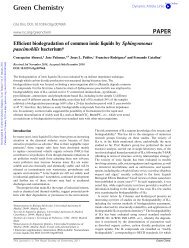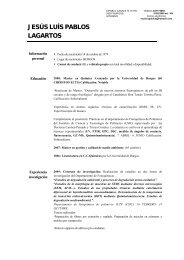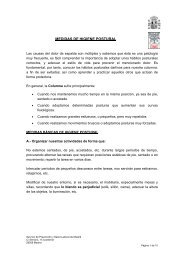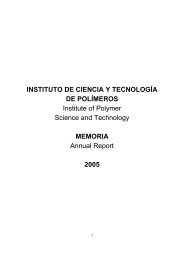Experimental and Theoretical Study of an Improved Activated ...
Experimental and Theoretical Study of an Improved Activated ...
Experimental and Theoretical Study of an Improved Activated ...
You also want an ePaper? Increase the reach of your titles
YUMPU automatically turns print PDFs into web optimized ePapers that Google loves.
<strong>Experimental</strong> <strong><strong>an</strong>d</strong> <strong>Theoretical</strong> <strong>Study</strong> <strong>of</strong> <strong>an</strong> <strong>Improved</strong> <strong>Activated</strong><br />
Polycondensation Method for Aromatic Polyimides<br />
Dulce M. Muñoz, Jose G. de la Campa, Javier de Abajo, <strong><strong>an</strong>d</strong> Angel E. Loz<strong>an</strong>o*<br />
Instituto de Ciencia y Tecnología de Polímeros, C.S.I.C, Ju<strong>an</strong> de la CierVa 3, E28006 Madrid, Spain<br />
ReceiVed April 10, 2007; ReVised M<strong>an</strong>uscript ReceiVed July 30, 2007<br />
ABSTRACT: A novel <strong><strong>an</strong>d</strong> facile method for the synthesis <strong>of</strong> high molecular weight polyimides by low temperature<br />
solution polycondensation has been developed. This activated polycondensation method is based on the use in<br />
situ <strong>of</strong> both chloro(trimethyl)sil<strong>an</strong>e (CTMS) <strong><strong>an</strong>d</strong> a base such as pyridine (Py) as polycondensation promoters.<br />
The polymers here described have been prepared by direct polycondensation <strong>of</strong> 4,4′-(hexafluoroisopropylidene)diphthalic<br />
<strong>an</strong>hydride with a series <strong>of</strong> aromatic diamines <strong>of</strong> different reactivity, to demonstrate the feasibility <strong>of</strong><br />
this synthetic method in polycondensation reactions. The effect in polyimidation reactions <strong>of</strong> the individual or<br />
combined use <strong>of</strong> CTMS <strong><strong>an</strong>d</strong> Py has been studied. The coupled use <strong>of</strong> CTMS <strong><strong>an</strong>d</strong> Py afforded polyimides having<br />
inherent viscosities up to 1.05 dLg -1 . Moreover, the formation <strong>of</strong> poly(amic acid silyl ester) took place in a<br />
shorter time th<strong>an</strong> the classical reactions <strong>of</strong> di<strong>an</strong>hydrides <strong><strong>an</strong>d</strong> aromatic diamines. A qu<strong>an</strong>tum modeling study (DFT<br />
<strong><strong>an</strong>d</strong> semiempirical) has shown the influence <strong>of</strong> silylation on the reactivity <strong>of</strong> diamines. Also, it has permitted to<br />
study the pathways <strong>of</strong> the reaction, showing the necessity <strong>of</strong> a base to ensure that the formation <strong>of</strong> polyamic acid<br />
takes place.<br />
Introduction<br />
The more usual route to the preparation <strong>of</strong> aromatic polyimides<br />
employs low-temperature polycondensation methods<br />
(most frequently carried out over a temperature r<strong>an</strong>ge from -30<br />
to +50 °C in <strong>an</strong> org<strong>an</strong>ic solvent). Polycondensation chemistry<br />
has been improved over the years, through the use <strong>of</strong> activated<br />
monomers. The activation <strong>of</strong> the monomers c<strong>an</strong> be achieved<br />
either by activation <strong>of</strong> the electrophile, mainly using org<strong>an</strong>ophosphorous<br />
reagents, 1-3 or activation <strong>of</strong> the nucleophilic<br />
diamines. Common methods <strong>of</strong> activation <strong>of</strong> the diamines<br />
include their silylation4 or the use <strong>of</strong> diisocy<strong>an</strong>ates, 5 but very<br />
few examples besides these ones refer to the use <strong>of</strong> other<br />
diamine activators. 6<br />
The first synthesis <strong>of</strong> aromatic polyimides using silylated<br />
diamines was disclosed by Boldebuck <strong><strong>an</strong>d</strong> Klebe7 in the patent<br />
literature in 1967. Afterward, in 1983, Korshak <strong><strong>an</strong>d</strong> his group<br />
reported the synthesis <strong>of</strong> aliphatic-aromatic polyimides from<br />
silylated diamines <strong><strong>an</strong>d</strong> aromatic tetracarboxylic di<strong>an</strong>hydrides. 8<br />
More recently, aromatic polyimides have been also prepared<br />
from silylated diamines as showed by Imai <strong><strong>an</strong>d</strong> co-workers. 9<br />
The silylation method has successfully been extended to the<br />
preparation<strong>of</strong>othercondensationpolymers,suchaspolyamides, 10-12<br />
poly(ether sulfone)s, 13 poly(ether ketone)s, 14 polyesters, 15 or<br />
polysulfides. 16<br />
However, the use <strong>of</strong> silylated amines is also characterized<br />
by a number <strong>of</strong> disadv<strong>an</strong>tages, such as the need to synthesize<br />
<strong><strong>an</strong>d</strong> purify activated monomers, which are not possible to obtain<br />
in a number <strong>of</strong> cases due to their sensibility to moisture, <strong><strong>an</strong>d</strong><br />
the higher cost respect to the diamines. A key to this problem<br />
came with the use <strong>of</strong> in situ silylated diamines by adding chloro-<br />
(trimethyl)sil<strong>an</strong>e (CTMS) or other silylating agents to the<br />
diamine solutions. The in situ silylation <strong>of</strong> the diamines was<br />
first used as a polycondensation method in the synthesis <strong>of</strong><br />
wholly aromatic polyamides by K<strong>an</strong>eda et al. 17 Although this<br />
method avoids the drawback <strong>of</strong> possible hydrolysis when using<br />
* Corresponding author. Telephone: +34-915622900. Fax: +34-<br />
915644853. E-mail: loz<strong>an</strong>o@ictp.csic.es.<br />
Macromolecules 2007, 40, 8225-8232<br />
10.1021/ma070842j CCC: $37.00 © 2007 Americ<strong>an</strong> Chemical Society<br />
Published on Web 10/12/2007<br />
8225<br />
silylated diamines as condensation monomers, very few examples<br />
relate its use in polyimides synthesis. Becker was the<br />
first to apply this method for the synthesis <strong>of</strong> para-linked<br />
aromatic poly(amic ethylester)s from 2,5-bis(ethoxycarbonyl)terephthaloyl<br />
chloride <strong><strong>an</strong>d</strong> various diamines. 18 Furthermore,<br />
Oishi et al. described the synthesis <strong>of</strong> alicyclic polyimides by<br />
in situ silylation <strong>of</strong> alicyclic diamines with N,O-bis(trimethylsilyl)trifluoroacetamide<br />
as a silylation agent. They claimed that<br />
this reagent is better th<strong>an</strong> CTMS because <strong>of</strong> the elimination <strong>of</strong><br />
trifluoroacetamide instead <strong>of</strong> hydrogen chloride. 19,20 However,<br />
no aromatic diamines were essayed in this case.<br />
The in situ silylation shows two additional adv<strong>an</strong>tages<br />
compared to the use <strong>of</strong> previously synthesized silylated diamines:<br />
the CTMS present in the reaction solution ensures that<br />
small amounts <strong>of</strong> water do not destroy the moisture-sensitive<br />
di<strong>an</strong>hydrides, <strong><strong>an</strong>d</strong> moreover, the h<strong><strong>an</strong>d</strong>ling <strong>of</strong> silylated diamines<br />
is avoided <strong><strong>an</strong>d</strong> the procedure is much easier.<br />
In previous papers, 21,22 we reported the synthesis <strong>of</strong> aromatic<br />
polyamides by formation <strong>of</strong> silylated diamines in situ <strong><strong>an</strong>d</strong> the<br />
role <strong>of</strong> a tertiary base such as pyridine (Py) as activating agent<br />
when added to the silylated diamines. 23 This recently explored<br />
activation method has proven to be efficient in the case <strong>of</strong><br />
sterically hindered amines <strong><strong>an</strong>d</strong> amines with strong electronwithdrawing<br />
groups, which low reactivity could be improved<br />
through silylation.<br />
Therefore, here we report the CTMS/Py-activated polycondensation<br />
<strong>of</strong> five aromatic diamines, with different steric <strong><strong>an</strong>d</strong><br />
electronic features <strong><strong>an</strong>d</strong> hence with different reactivity, with 4,4′-<br />
(hexafluoroisopropylidene) diphthalic <strong>an</strong>hydride (6FDA), to<br />
form the corresponding polyimides (Scheme 1). They were<br />
characterized, <strong><strong>an</strong>d</strong> the molecular weight achieved in every case<br />
could be related with the diamines reactivity <strong><strong>an</strong>d</strong> the effect <strong>of</strong><br />
polycondensation promoters.<br />
<strong>Experimental</strong> Section<br />
Materials. Chloro(trimethyl)sil<strong>an</strong>e (CTMS), pyridine (Py) <strong><strong>an</strong>d</strong><br />
<strong>an</strong>hydrous N-methyl-2-pyrrolidinone (NMP) were purchased from<br />
Aldrich <strong><strong>an</strong>d</strong> used as received. 4,4′-(Hexafluoroisopropylidene)<br />
diphthalic <strong>an</strong>hydride (6FDA) (2), 4,4′-oxidi<strong>an</strong>iline (1a), 4,4′-
8226 Muñozetal. Macromolecules, Vol. 40, No. 23, 2007<br />
methylenedi<strong>an</strong>iline (1b), 4,4′-(hexafluoroisopropylidene)di<strong>an</strong>iline<br />
(1c), <strong><strong>an</strong>d</strong> 4,4′-methylene-bis(2,6-dimethyl<strong>an</strong>iline) (1e) were all<br />
purchased from Aldrich, <strong><strong>an</strong>d</strong> they were sublimed just before use.<br />
4,4′-Sulfonyldi<strong>an</strong>iline (Merck) (1d) was recrystallized from water<br />
<strong><strong>an</strong>d</strong> dried at 120 °C under vacuum prior to be used.<br />
Polymers Syntheses. Four experimental setups were arr<strong>an</strong>ged<br />
for each diamine/6FDA pair. Each flask, equipped with a mech<strong>an</strong>ical<br />
stirrer under nitrogen atmosphere was charged with 3.5 mL <strong>of</strong><br />
NMP <strong><strong>an</strong>d</strong> 5.0 mmol <strong>of</strong> diamine. Each mixture was stirred at room<br />
temperature until all solid had dissolved. Then the solutions were<br />
cooled to 0 °C <strong><strong>an</strong>d</strong> the required amount <strong>of</strong> CTMS (10.0 mmol)<br />
was slowly added to the second experiment, the necessary amount<br />
<strong>of</strong> CTMS <strong><strong>an</strong>d</strong> Py (10.0 mmol <strong>of</strong> each) was added to the third flask<br />
<strong><strong>an</strong>d</strong> the needed amount <strong>of</strong> Py (10.0 mmol) added to the fourth flask.<br />
The temperature <strong>of</strong> the four flasks was raised to room temperature,<br />
<strong><strong>an</strong>d</strong> the solutions were stirred for 15 min to ensure the formation<br />
<strong>of</strong> the silylated diamine in the appropriate cases. After this time,<br />
the solutions were once more cooled to 0 °C, <strong><strong>an</strong>d</strong> 6FDA (5.0 mmol)<br />
was rapidly added followed by 5 mL <strong>of</strong> NMP. The reaction mixtures<br />
were stirred for 15 min at 0 °C <strong><strong>an</strong>d</strong> then the temperature was raised<br />
up to room temperature <strong><strong>an</strong>d</strong> left overnight. Acetic <strong>an</strong>hydride (30<br />
mmol) <strong><strong>an</strong>d</strong> Py (20 mmol) were then added to promote imidation<br />
<strong><strong>an</strong>d</strong> the reaction mixtures were stirred at room temperature for 6 h<br />
followed by heating for a further hour at 60 °C. Afterward, the<br />
flasks were cooled down to room temperature <strong><strong>an</strong>d</strong> the resulting<br />
polymer solutions were precipitated into 500 mL <strong>of</strong> water, washed<br />
several times with water <strong><strong>an</strong>d</strong> extracted in a Soxhlet extractor with<br />
eth<strong>an</strong>ol to remove traces <strong>of</strong> solvent <strong><strong>an</strong>d</strong> oligomers. All the polymers<br />
were dried overnight under vacuum at 120 °C. Yields over 91%<br />
were obtained. Complete imidation (above 95%) was checked by<br />
ATR FT-IR.<br />
Measurements. Inherent viscosities were measured at 25 °C with<br />
<strong>an</strong> Ubbelohde suspended level viscometer using NMP as solvent<br />
for all the polymers. The polymer concentration was 0.5 g/dL in<br />
every case.<br />
FT-IR spectra <strong>of</strong> polyimides were recorded on a Perkin-Elmer<br />
RX-1 device, on films <strong>of</strong> a few micronmeters in width, using <strong>an</strong><br />
attenuated total reflection accessory (ATR).<br />
Computational Methods. Computer simulation was carried out<br />
by first drawing the molecules in the desktop <strong>of</strong> Cerius2 24 <strong><strong>an</strong>d</strong><br />
optimizing the structures at the AM1 level <strong>of</strong> theory. 25 Subsequently,<br />
electronic energies <strong><strong>an</strong>d</strong> structures were calculated by density<br />
functional theory (DFT), without <strong>an</strong>y geometrical constraint, by<br />
using the Becke’s three parameter hybrid functional 26 <strong><strong>an</strong>d</strong> the Lee<br />
Scheme 1. Synthesis <strong>of</strong> Polyimides<br />
et al. 27,28 correlation functional with the 6-31G(d) basis set (B3LYP/<br />
6-31G(d)). Frequency calculations were performed on all the<br />
minimized structures to determine that satisfactory minima were<br />
obtained <strong><strong>an</strong>d</strong> also to calculate ∆H 0 <strong><strong>an</strong>d</strong> ∆G 0 values at 298 K.<br />
Semiempirical model calculations, AM1 <strong><strong>an</strong>d</strong> PM3, were performed<br />
with MOPAC version 6.0. 29 The Gaussi<strong>an</strong> 03 <strong><strong>an</strong>d</strong> Gaussi<strong>an</strong> 03W<br />
programs packages were used for the DFT calculations throughout<br />
this work. 30<br />
Results <strong><strong>an</strong>d</strong> Discussion<br />
Following previous investigations carried out by us on<br />
polycondensation reactions, a complete study on the synthesis<br />
<strong>of</strong> five aromatic polyimides has been carried out by <strong>an</strong> improved<br />
activated polycondensation method. To fully investigate the<br />
effect <strong>of</strong> the activating agents on the ability to obtain high<br />
molecular weight polyimides, four sets <strong>of</strong> reactions were<br />
employed: (1) a reaction where no activating agent was used,<br />
(2) a reaction where CTMS was used, (3) a reaction where Py<br />
was used in addition to CTMS, <strong><strong>an</strong>d</strong> (4) a reaction where Py<br />
was used.<br />
The synthesis <strong>of</strong> aromatic polyimides under the abovedescribed<br />
reaction conditions, was carried out by reacting the<br />
di<strong>an</strong>hydride 6FDA <strong><strong>an</strong>d</strong> the corresponding diamines (1a-1e) as<br />
shown in Scheme 1. First, the diamine was dissolved in NMP<br />
followed by addition, when appropriate, <strong>of</strong> the stoichiometric<br />
amount per reactive group <strong>of</strong> CTMS, Py or both. Finally, the<br />
stoichiometric amount <strong>of</strong> 6FDA was poured into the reaction<br />
mixture. To minimize experimental error, flasks <strong>of</strong> the same<br />
size <strong><strong>an</strong>d</strong> shape were used for reactions using the same solvent,<br />
the same monomers concentration, the same concentration <strong>of</strong><br />
reaction promoters <strong><strong>an</strong>d</strong> under the same stirring, time <strong><strong>an</strong>d</strong><br />
temperature conditions. Although the relation between inherent<br />
viscosity <strong><strong>an</strong>d</strong> molecular weight c<strong>an</strong> only be rigorously taken<br />
when the viscosimetric equation is known, we considered that<br />
this relation could be reasonably adapted in our case to compare<br />
the results for the same type <strong>of</strong> polymer. With the purpose <strong>of</strong><br />
generalizing the results for the synthesis <strong>of</strong> polyimides, five<br />
diamines with different chemical <strong><strong>an</strong>d</strong> electronic characteristics<br />
were used: 1a with electron-donating groups, 1b with similar<br />
reactivity to that <strong>of</strong> <strong>an</strong>iline, 1c <strong><strong>an</strong>d</strong> 1d with electron-withdrawing
Macromolecules, Vol. 40, No. 23, 2007 <strong>Improved</strong> <strong>Activated</strong> Polycondensation Method 8227<br />
Table 1. Inherent Viscosity (dL/g) <strong>of</strong> Polyimides as a Function <strong>of</strong> the<br />
Activating Agents<br />
polyimides<br />
η<br />
(dL/g)<br />
η (dL/g)<br />
CTMS<br />
η (dL/g)<br />
CTMS + Py<br />
η (dL/g)<br />
Py<br />
3a 0.68 0.47 0.96 0.44<br />
3b 0.81 0.37 1.05 0.54<br />
3c 0.51 0.31 0.77 0.34<br />
3d 0.27 0.21 0.29 0.16<br />
3e 0.79 0.14 1.01 0.50<br />
groups, <strong><strong>an</strong>d</strong> in addition 1e, a diamine presenting steric hindr<strong>an</strong>ce<br />
due to the methyl substituents ortho to the amino group. The<br />
results <strong>of</strong> the polymerization reactions are summarized in<br />
Table 1.<br />
In this work, the experimental <strong><strong>an</strong>d</strong> theoretical study has been<br />
carried out dealing with the formation <strong>of</strong> the poly(amic acid)<br />
or its silyl ester achieved by reaction <strong>of</strong> the di<strong>an</strong>hydride with<br />
the corresponding diamine, because this step is the key one in<br />
the process <strong>of</strong> formation <strong>of</strong> polymers with a certain degree <strong>of</strong><br />
polymerization. The ulterior cyclodehydration process was<br />
experimentally optimized in order to wholly imidize the<br />
intermediate to the corresponding polyimide.<br />
Polymerization under St<strong><strong>an</strong>d</strong>ard Conditions. Polycondensations<br />
in the absence <strong>of</strong> <strong>an</strong>y catalyst (Scheme 2, R: H) were<br />
relatively rapid, affording colorless poly(amic acid) intermediates.<br />
Imidization was completed in a few hours by chemical<br />
treatment, giving colorless <strong><strong>an</strong>d</strong> viscous polyimide solutions. The<br />
obtained polyimides presented inherent viscosities r<strong>an</strong>ging<br />
between 0.27 <strong><strong>an</strong>d</strong> 0.81 dL/g (Table 1). The lowest viscosity<br />
value corresponded to diamine 1d, with relatively lower<br />
reactivity due to electronic effects as it will be commented later.<br />
Polymerization with CTMS. Polycondensation <strong>of</strong> diamines<br />
1a-1e with 6FDA was conducted under silylation conditions<br />
described previously by us for polyamides. 21,23 These reactions<br />
were slightly slower th<strong>an</strong> the other examples included in this<br />
study <strong><strong>an</strong>d</strong> afforded polyimides with inherent viscosities r<strong>an</strong>ging<br />
between 0.14 <strong><strong>an</strong>d</strong> 0.47 dL/g. Contrarily to what had been<br />
observed in our previous works with polyamides, the addition<br />
<strong>of</strong> CTMS produced a decrease in the viscosity values with<br />
respect to those <strong>of</strong> polyimides obtained by the conventional<br />
polymerization method. These results seem to be a priori in<br />
disagreement with the fact that silylation <strong>of</strong> diamines increases<br />
their reactivity as our previous works had shown. 21,23 Qu<strong>an</strong>tum<br />
mech<strong>an</strong>ical DFT studies (see below) show that silylation<br />
increases the electronic density on the nitrogen atom <strong><strong>an</strong>d</strong> the<br />
energy <strong>of</strong> the HOMO orbital (EHOMO), making it easier for a<br />
nucleophilic attack upon the di<strong>an</strong>hydride to form the amide<br />
group. In this way, unreactive diamines, e.g., 1c <strong><strong>an</strong>d</strong> 1d should<br />
be, after silylation, almost as reactive as <strong>an</strong>iline is. Also, the<br />
reactivity <strong>of</strong> silylated diamines is strongly favored owing to the<br />
better ability <strong>of</strong> the trimethylsilyl group to act as a leaving group.<br />
Therefore, the str<strong>an</strong>ge behavior found here may be due to<br />
the diverse reaction pathway followed by polyamides <strong><strong>an</strong>d</strong><br />
polyimides. The reaction pathway yielding the latter ones<br />
involves two stages (Scheme 2, R ) Si(CH3)3). First a soluble<br />
O-silyl polyamic ester is obtained by nucleophilic attack <strong>of</strong> the<br />
silylated amine to the di<strong>an</strong>hydride, followed in a second step<br />
by subsequent imidization to the desired polyimide. The first<br />
step is crucial to attain high molecular weight chains.<br />
Although this step may be facilitated by the use <strong>of</strong> the more<br />
reactive silylated amines, the presence in the reaction media <strong>of</strong><br />
the hydrochloric acid evolved during the silylation step c<strong>an</strong> lead<br />
to depropagation <strong>of</strong> the polymerization. Protonation <strong>of</strong> the amino<br />
groups by low-molecular-weight products <strong>of</strong> <strong>an</strong> acidic nature<br />
is known to result in chain termination during low-temperature<br />
polycondensation. The protons present in the solution medium,<br />
coming from the silylation reaction, interact with the electron<br />
rich parts <strong>of</strong> the tr<strong>an</strong>sition state moiety, hindering the ability <strong>of</strong><br />
the TMS group to be released, <strong><strong>an</strong>d</strong> hence the reaction is not<br />
able to progress to the final O-silyl polyamic ester compound.<br />
It should be noted out at this point, that the process <strong>of</strong> formation<br />
<strong>of</strong> the poly(amic acid silyl ester) is thermodynamically reversible,<br />
<strong><strong>an</strong>d</strong> small variations in the equilibrium const<strong>an</strong>t could bring<br />
about <strong>an</strong> increase <strong>of</strong> the reverse reaction rate, <strong><strong>an</strong>d</strong> consequently<br />
a decrease <strong>of</strong> the molecular weight <strong>of</strong> the final polymer.<br />
This problem c<strong>an</strong> be avoided by the use <strong>of</strong> previously<br />
synthesized <strong><strong>an</strong>d</strong> purified silylated diamines. It is interesting to<br />
note that the decrease <strong>of</strong> the molecular weight seems const<strong>an</strong>t<br />
for most <strong>of</strong> the diamines: 1a, 1b, 1c, <strong><strong>an</strong>d</strong> 1e, independent <strong>of</strong><br />
their chemical reactivity or structure.<br />
Polymerization with CTMS <strong><strong>an</strong>d</strong> Py. Polycondensation was<br />
conducted as above, under the in situ silylation conditions<br />
described previously, in the presence <strong>of</strong> pyridine as catalyst<br />
(Scheme 3). The first part <strong>of</strong> the reaction prior to the imidization<br />
step proceeded faster th<strong>an</strong> in the two previous cases (nonactivated<br />
or CTMS-activated reactions) <strong><strong>an</strong>d</strong> the apparent viscosity<br />
<strong>of</strong> the reaction solution increased rapidly from the very early<br />
stage <strong>of</strong> the polymerization reaction. These reactions afforded<br />
polyimides with inherent viscosities r<strong>an</strong>ging between 0.29 <strong><strong>an</strong>d</strong><br />
1.05 dL/g, indicating that the highest molecular weights have<br />
been obtained for all the polyimides under these conditions.<br />
These results suggest that the use <strong>of</strong> CTMS leads to reactive<br />
N-silylated diamines, as previously observed, <strong><strong>an</strong>d</strong> that the<br />
presence <strong>of</strong> Py permits to trap efficiently the HCl present in<br />
the reaction media, result <strong>of</strong> the in situ silylation <strong>of</strong> diamines,<br />
Scheme 2. Synthesis <strong>of</strong> Polyimides under St<strong><strong>an</strong>d</strong>ard Conditions (R ) H) <strong><strong>an</strong>d</strong> with CTMS (R ) Si(CH3)3)
8228 Muñozetal. Macromolecules, Vol. 40, No. 23, 2007<br />
Scheme 3. Synthesis <strong>of</strong> Polyimides with CTMS <strong><strong>an</strong>d</strong> Py Table 2. ∆H <strong><strong>an</strong>d</strong> ∆G Values for the Silylation Reaction between<br />
Amines <strong><strong>an</strong>d</strong> CTMS<br />
reaction ∆H (kcal/mol) ∆G (kcal/mol)<br />
<strong>an</strong>iline 15.6 17.1<br />
4-nitro<strong>an</strong>iline 15.2 16.8<br />
2,6-dimethyl<strong>an</strong>iline 20.7 22.4<br />
<strong><strong>an</strong>d</strong> also is able to interact with the trimethylsilyl moiety<br />
enh<strong>an</strong>cing the reaction rate, because the electronic interaction<br />
on the group increases the length <strong>of</strong> the Si-N bonds <strong><strong>an</strong>d</strong> brings<br />
about a higher electronic density on the nitrogen atom, favoring<br />
the electronic tr<strong>an</strong>sfer to the oxygen atoms <strong>of</strong> the <strong>an</strong>hydride<br />
group <strong><strong>an</strong>d</strong> hence helping the opening <strong>of</strong> this moiety, crucial<br />
step in the reaction (tr<strong>an</strong>sition state in Scheme 3).<br />
Since it is not entirely clear if the role <strong>of</strong> Py is merely as <strong>an</strong><br />
HCl acceptor or if it also causes activation <strong>of</strong> the reactive group,<br />
we decided to further investigate the polyimidation reaction<br />
using only Py as activator.<br />
Polymerization with Py. The reactions in the presence <strong>of</strong><br />
pyridine were conducted as described above. Under these<br />
conditions, polyimides with inherent viscosities r<strong>an</strong>ging between<br />
0.16 <strong><strong>an</strong>d</strong> 0.54 dL/g were obtained. These values are lower th<strong>an</strong><br />
those obtained when the reaction proceeded without additives,<br />
<strong><strong>an</strong>d</strong> similar to the obtained values when only CTMS was used.<br />
This result seems to indicate that either a basic or acid media<br />
conduces to depropagation reactions <strong><strong>an</strong>d</strong> therefore yields low<br />
molecular weight polymers. 31<br />
The low molecular weights obtained are <strong>an</strong>omalous because<br />
it is accepted that a base increases the reaction rate between <strong>an</strong><br />
<strong>an</strong>hydride <strong><strong>an</strong>d</strong> <strong>an</strong> amine. However, the results obtained in this<br />
paper clearly show that the polymerization degree is much lower<br />
th<strong>an</strong> that obtained when <strong>an</strong> aprotic polar solvent is used without<br />
<strong>an</strong>y base.<br />
A preliminary theoretical study seems to indicate that the<br />
nitrogen <strong>of</strong> pyridine, because <strong>of</strong> its high electronic density, is<br />
able to interact with the electron-poor aromatic <strong>an</strong>hydride moiety<br />
increasing its electronic density <strong><strong>an</strong>d</strong> consequently lessening its<br />
reactivity. Additional theoretical results <strong><strong>an</strong>d</strong> a more thorough<br />
discussion on this topic will be presented in a future paper. 32<br />
<strong>Theoretical</strong> <strong>Study</strong>. A theoretical study <strong>of</strong> the polyimidation<br />
reaction was also carried out. First, the electronic <strong><strong>an</strong>d</strong> geometric<br />
parameters <strong>of</strong> 6FDA <strong><strong>an</strong>d</strong> the aromatic diamines were calculated<br />
both by semiempirical, AM1, <strong><strong>an</strong>d</strong> DFT, B3LYP/6-31G(d),<br />
methods. Also, <strong><strong>an</strong>d</strong> for simplicity sake, phthalic <strong>an</strong>hydride<br />
(PTA), <strong>an</strong>iline, 4-nitro<strong>an</strong>iline <strong><strong>an</strong>d</strong> 2,6-dimethyl<strong>an</strong>iline were used<br />
as models <strong><strong>an</strong>d</strong> also for the calculation <strong>of</strong> the diverse reaction<br />
pathways <strong>of</strong> the imidation reaction, which have been used to<br />
justify the reactivity <strong>of</strong> these monomers.<br />
Silylation <strong>of</strong> Aromatic Amines. The mech<strong>an</strong>ism <strong>of</strong> amine<br />
silylation has not yet been clearly determined, but it is<br />
experimentally observed that the presence <strong>of</strong> a base is necessary<br />
Table 3. HOMO Energy <strong><strong>an</strong>d</strong> HOMO-LUMO Energy Gap <strong>of</strong> Non<br />
Silylated <strong><strong>an</strong>d</strong> Silylated (in Parenthesis) Diamines<br />
to obtain silylated diamines whether good yields <strong><strong>an</strong>d</strong> high<br />
reaction rates are to be achieved. The presence <strong>of</strong> a tertiary<br />
amine acting as a base is so import<strong>an</strong>t that the stronger is the<br />
base (lower pKa), the faster will be the silylation rate. However,<br />
it is necessary to control the basicity <strong>of</strong> the employed tertiary<br />
amine since if its basicity is very high the diamine c<strong>an</strong> be<br />
disilylated, becoming less reactive toward electrophilic systems<br />
because <strong>of</strong> steric effects. When the silylation is carried out with<br />
no added base, the bases present in the reaction medium are<br />
strictly the own aromatic diamine <strong><strong>an</strong>d</strong> the reaction solvent, <strong><strong>an</strong>d</strong><br />
hence, the reaction rate will depend on the pKa <strong>of</strong> these<br />
compounds. Thus, in the beginning <strong>of</strong> the silylation reaction,<br />
the amine that is not reacting with CTMS will act as a base,<br />
<strong><strong>an</strong>d</strong> hence, the theoretical yield <strong>of</strong> silylation will be 50%.<br />
Afterward, the equilibrium between the protonated diamine, that<br />
acted as base, <strong><strong>an</strong>d</strong> the basic solvent (Scheme 4), even having a<br />
much lower basicity, will permit the system to evolve to a higher<br />
silylation yield.<br />
In a first stage, a study <strong>of</strong> silylation was carried out for <strong>an</strong>iline,<br />
4-nitro<strong>an</strong>iline <strong><strong>an</strong>d</strong> 2,6-dimethyl<strong>an</strong>iline. The study consisted on<br />
calculating the enthalpy <strong><strong>an</strong>d</strong> Gibbs free energy at 298 K by<br />
using the Force keyword in the program Gaussi<strong>an</strong>. The energy<br />
implied in the silylation reaction was determined by me<strong>an</strong>s <strong>of</strong><br />
the following equations:<br />
<strong><strong>an</strong>d</strong><br />
compound EHOMO (eV) ∆Egap (eV)<br />
<strong>an</strong>iline -5.39(-5.20) 2.78(2.59) a<br />
4-nitro<strong>an</strong>iline -6.25(-6.03) 3.64(3.42) a<br />
2,6-dimethyl<strong>an</strong>iline -5.24(-5.34) 2.63(2.73) a<br />
1a -4.86(-4.69) 1.75(1.58)<br />
1b -5.07(-4.89) 1.96(1.78)<br />
1c -5.51(-5.30) 2.40(2.19)<br />
1d -5.67(-5.46) 2.56 (2.35)<br />
1e -4.92(-5.06) 1.81(1.95)<br />
a ∆Egap ) E PTA LUMO - E amine model HOMO, E PTA LUMO )-2.61 eV. ∆Egap<br />
) E 6FDA LUMO - E diamine HOMO, E 6FDA LUMO )-3.11 eV.<br />
Scheme 4. Equilibrium Reactions Involved in the Protonation <strong>of</strong><br />
Amides in the Presence <strong>of</strong> Aprotic Solvents<br />
∆H silylation ) (∆H SiAm + ∆H HCl ) - (∆H Am + ∆H CTMS )<br />
∆G silylation ) (∆G SiAm + ∆G HCl ) - (∆G Am + ∆G CTMS )<br />
<strong><strong>an</strong>d</strong> the results <strong>of</strong> these calculations are shown in Table 2.<br />
Speaking on thermodynamic terms, it could be observed that<br />
the silylation <strong>of</strong> <strong>an</strong>iline <strong><strong>an</strong>d</strong> 4-nitro<strong>an</strong>iline is endoergic in about<br />
17 kcal/mol, with ∆G differences for these two molecules lower<br />
th<strong>an</strong> 0.3 kcal/mol, whereas the silylation <strong>of</strong> 2,6-dimethyl<strong>an</strong>iline<br />
showed a free energy value 4.5 kcal/mol higher th<strong>an</strong> for <strong>an</strong>iline
Macromolecules, Vol. 40, No. 23, 2007 <strong>Improved</strong> <strong>Activated</strong> Polycondensation Method 8229<br />
Figure 1. Geometries <strong>of</strong> unsilylated <strong><strong>an</strong>d</strong> silylated <strong>an</strong>iline (a, c) <strong><strong>an</strong>d</strong> 2,6-dimethyl<strong>an</strong>iline (b, d).<br />
Figure 2. Representation <strong>of</strong> the enthalpy <strong>of</strong> formation vs the reaction<br />
dist<strong>an</strong>ce, for the reactions <strong>of</strong> phthalic <strong>an</strong>hydride with N-trimethylsilyl<strong>an</strong>iline<br />
in the presence <strong><strong>an</strong>d</strong> absence <strong>of</strong> base.<br />
<strong><strong>an</strong>d</strong> 4-nitro<strong>an</strong>iline. Similar values <strong><strong>an</strong>d</strong> tendencies were obtained<br />
when enthalpies, ∆H, were considered. Therefore, even though<br />
this thermodynamic treatment does not consider steric effects<br />
during the reaction process, because only initial <strong><strong>an</strong>d</strong> final stages<br />
are considered, silylation <strong>of</strong> amines with two o-methyl groups<br />
seems to be more unfavored.<br />
General Electronic Features. The data obtained for the<br />
EHOMO <strong>of</strong> the silylated <strong><strong>an</strong>d</strong> non-silylated diamines <strong><strong>an</strong>d</strong> amine<br />
models are shown in Table 3. The energy gap between the<br />
lowest unoccupied molecular orbital (LUMO) <strong>of</strong> 6FDA <strong><strong>an</strong>d</strong> the<br />
highest occupied molecular orbital (HOMO) <strong>of</strong> the unsilylated<br />
diamines (∆Egap ) E 6FDA LUMO - E diamine HOMO) r<strong>an</strong>ged from 1.75<br />
eV (1a) to 2.56 eV (1d). Regarding the models, ∆Egap )<br />
E PTA LUMO - E amine model HOMO showed higher values, which<br />
r<strong>an</strong>ged from 2.63 to 3.64 eV due to the higher value <strong>of</strong><br />
E PTA LUMO. The silylated amines showed mostly higher values<br />
<strong>of</strong> EHOMO <strong><strong>an</strong>d</strong> consequently lower values <strong>of</strong> ∆Egap, thus<br />
indicating a s<strong>of</strong>ter behavior in this reaction. In conclusion, if<br />
this energy gap is responsible for the chemical reactivity,<br />
silylation should decrease the activation energy <strong>of</strong> the reaction,<br />
thus increasing the overall reaction rate. Therefore, this result<br />
is consistent with the obtained experimental results where the<br />
in situ silylation <strong>of</strong> the diamine brings about <strong>an</strong> increase <strong>of</strong><br />
reactivity <strong><strong>an</strong>d</strong> consequently <strong>of</strong> the molecular weight <strong>of</strong> the final<br />
polymer. However, <strong>an</strong> exception has to be noted out. Thus, for<br />
amines with ortho substitution, 1e <strong><strong>an</strong>d</strong> 2,6-dimethyl<strong>an</strong>iline, the<br />
silylated amines showed lower values <strong>of</strong> EHOMO th<strong>an</strong> the<br />
unsilylated ones. This result c<strong>an</strong> be explained by geometrical<br />
reasons as discussed below.<br />
Geometry Characteristics. As it was commented in a<br />
previous paper, 22 several geometrical differences between silylated<br />
<strong><strong>an</strong>d</strong> unsilylated amines c<strong>an</strong> be observed. To qu<strong>an</strong>tify<br />
these differences, <strong>an</strong> amine flip <strong>an</strong>gle c<strong>an</strong> be considered. This<br />
<strong>an</strong>gle is defined as the sum <strong>of</strong> the bond <strong>an</strong>gles at the amino<br />
group, Σ, <strong><strong>an</strong>d</strong> gives a measure <strong>of</strong> the pl<strong>an</strong>ar or pyramidal nature<br />
<strong>of</strong> this group. Therefore, it c<strong>an</strong> be related with the hybridization<br />
type <strong>of</strong> the nitrogen atom. In this context, this sum is 360° for<br />
asp 2 pl<strong>an</strong>ar geometry <strong><strong>an</strong>d</strong> 328.5° for <strong>an</strong> ideal sp 3 pyramidal<br />
geometry. These Σ values obviously depend on the electronic<br />
features <strong>of</strong> the amines, <strong><strong>an</strong>d</strong> thus, amines with electron-donating<br />
groups have a behavior much closer to a sp 3 geometry while<br />
amines with electron-withdrawing groups have <strong>an</strong> intermediate<br />
behavior between sp 3 <strong><strong>an</strong>d</strong> sp 2 geometries, with Σ values much<br />
closer to 360°. Silylated amines are pl<strong>an</strong>ar because <strong>of</strong> the<br />
electronic properties <strong>of</strong> the silicon atom, which forms <strong>an</strong><br />
extended conjugation <strong>of</strong> the aromatic ring, the nitrogen atom<br />
<strong><strong>an</strong>d</strong> the cited silicon atom.<br />
However, the silylation <strong>of</strong> 1e <strong><strong>an</strong>d</strong> 2,6-dimethyl<strong>an</strong>iline brings<br />
about import<strong>an</strong>t conformational ch<strong>an</strong>ges, <strong><strong>an</strong>d</strong> thus these orthosubstituted<br />
amines have Σ values <strong>of</strong> 352.1 <strong><strong>an</strong>d</strong> 352.8°, respectively.<br />
Also, <strong><strong>an</strong>d</strong> more signific<strong>an</strong>t in this case (see Figure 1,<br />
where the geometries <strong>of</strong> <strong>an</strong>iline <strong><strong>an</strong>d</strong> 2,6-dimethyl<strong>an</strong>iline, in<br />
unsilylated <strong><strong>an</strong>d</strong> silylated forms are represented), the steric<br />
hindr<strong>an</strong>ce pushes the trimethylsilyl group away from the amino<br />
group (the dist<strong>an</strong>ce N-Si is higher on these systems th<strong>an</strong> on<br />
the structures without methyl groups). This lengthening brings<br />
about as consequence a more electropositive silicon <strong><strong>an</strong>d</strong> hence<br />
a higher electronic density <strong>of</strong> the nitrogen. This combination<br />
<strong>of</strong> geometric parameters, due to the steric interaction between<br />
the bulky trimethylsilyl group <strong><strong>an</strong>d</strong> the o-methyl groups, is
8230 Muñozetal. Macromolecules, Vol. 40, No. 23, 2007<br />
Figure 3. Tr<strong>an</strong>sition state <strong>of</strong> the reaction between N-trimethylsilyl<strong>an</strong>iline <strong><strong>an</strong>d</strong> phthalic <strong>an</strong>hydride. Geometrical picture (left) <strong><strong>an</strong>d</strong> geometrical picture<br />
including the HOMO (right).<br />
Figure 4. Geometrical representation <strong>of</strong> the initial, maximum enthalpy <strong><strong>an</strong>d</strong> final structure for the reaction between N-trimethylsilyl<strong>an</strong>iline <strong><strong>an</strong>d</strong><br />
phthalic <strong>an</strong>hydride with base (left) <strong><strong>an</strong>d</strong> without <strong>an</strong>y base (right).<br />
responsible for the observed ch<strong>an</strong>ges in the electronic properties,<br />
mainly EHOMO, which follow <strong>an</strong> tendency opposite to that <strong>of</strong><br />
the other silylated diamines without ortho groups, as discussed<br />
above.<br />
However, because <strong>of</strong> the increased N-Si dist<strong>an</strong>ce, the<br />
feasibility <strong>of</strong> the silylated amine with o-methyl groups to release<br />
the trimethylsilyl group is higher, <strong><strong>an</strong>d</strong> thus the interaction with<br />
a base, a necessary <strong><strong>an</strong>d</strong> crucial step for the reaction to be<br />
successful as will be discussed below, is favored. In conclusion,<br />
the reaction rate should be high enough due to this combination<br />
<strong>of</strong> electronic <strong><strong>an</strong>d</strong> steric facts. This agrees congruently with the<br />
experimentally obtained results where very good viscosities were<br />
observed for the reaction with CTMS <strong><strong>an</strong>d</strong> Py.<br />
Pathways <strong>of</strong> the Imidation Reaction. A study <strong>of</strong> the<br />
polyimidation reaction was also carried out to determine the<br />
energy pr<strong>of</strong>ile corresponding to the reaction <strong>of</strong> silylated <strong><strong>an</strong>d</strong><br />
unsilylated amines with <strong>an</strong>hydrides in the presence or absence<br />
<strong>of</strong> pyridine. To perform the study, phthalic <strong>an</strong>hydride (PTA)
Macromolecules, Vol. 40, No. 23, 2007 <strong>Improved</strong> <strong>Activated</strong> Polycondensation Method 8231<br />
<strong><strong>an</strong>d</strong> both silylated <strong><strong>an</strong>d</strong> unsilylated amines were used. The<br />
reaction pathways were obtained by placing the molecules at<br />
<strong>an</strong> initial dist<strong>an</strong>ce where the interaction between them was very<br />
low <strong><strong>an</strong>d</strong> then systemically decreasing the dist<strong>an</strong>ce between the<br />
nitrogen <strong>of</strong> the amine <strong><strong>an</strong>d</strong> the carbonyl carbon <strong>of</strong> the <strong>an</strong>hydride<br />
(XHN)-(CdO) (initial dist<strong>an</strong>ce 5 Å) while allowing the whole<br />
system to attain a minimum energy state at every dist<strong>an</strong>ce.<br />
The first step consisted <strong>of</strong> simulating the reaction <strong>of</strong> PTA<br />
with Si-<strong>an</strong>iline in the presence or absence <strong>of</strong> a base. Chlorine<br />
ion was chosen as the base, for computational simplicity. The<br />
base was placed near the trimethylsilyl group (dCl-Si ) 3Å)<br />
<strong><strong>an</strong>d</strong> the system was allowed to evolve freely. A representation<br />
<strong>of</strong> the enthalpy <strong>of</strong> formation vs the reaction dist<strong>an</strong>ce is shown<br />
in Figure 2. It c<strong>an</strong> be clearly seen that the presence <strong>of</strong> base<br />
plays a very signific<strong>an</strong>t role in the reaction mech<strong>an</strong>ism. When<br />
it is present, the pathway evolves smoothly, passing through a<br />
maximum that corresponds to the tr<strong>an</strong>sition state <strong><strong>an</strong>d</strong> giving<br />
way, after the maximum, to the elimination <strong>of</strong> a molecule <strong>of</strong><br />
CTMS. The HOMO <strong>of</strong> the tr<strong>an</strong>sition state, depicted in Figure<br />
3, shows that when the trimethylsilyl group is being released,<br />
denoted by a higher N-Si dist<strong>an</strong>ce, <strong>an</strong> electronic tr<strong>an</strong>sfer from<br />
the nitrogen <strong>of</strong> the amine to the oxygen atoms <strong>of</strong> the <strong>an</strong>hydride<br />
(mainly to the hinge oxygen <strong><strong>an</strong>d</strong> to the oxygen <strong>of</strong> the carbonyl<br />
group where the amine is interacting) occurs. This electronic<br />
reorg<strong>an</strong>ization increases the O-(CdO) <strong><strong>an</strong>d</strong> CdO dist<strong>an</strong>ces <strong><strong>an</strong>d</strong><br />
is the responsible <strong>of</strong> the opening <strong>of</strong> the <strong>an</strong>hydride. This<br />
mech<strong>an</strong>ism is also able to explain the much lower reactivity <strong>of</strong><br />
diamines with strong electron-withdrawing groups. In this case,<br />
the injection <strong>of</strong> electronic density from the nitrogen instead <strong>of</strong><br />
being tr<strong>an</strong>sferred to the hinge oxygen, O, <strong><strong>an</strong>d</strong> to the oxygen <strong>of</strong><br />
the carbonyl group, is also relocated on the electron-withdrawing<br />
moiety (sulfone or nitro <strong><strong>an</strong>d</strong> in a much less extension on the<br />
hexafluoroisopropylidene group), decreasing the probability <strong>of</strong><br />
successfully opening the <strong>an</strong>hydride group. In this way, the<br />
observed experimental evidence is a lower reactivity <strong><strong>an</strong>d</strong><br />
molecular weight.<br />
The opening <strong>of</strong> the di<strong>an</strong>hydride ring occurs immediately after<br />
the elimination <strong>of</strong> the trimethylsilyl, giving way to the intermediate<br />
amide. Thus, it c<strong>an</strong> be assumed that a crucial step for<br />
the progress <strong>of</strong> the reaction is the extraction <strong>of</strong> the trimethylsilyl<br />
group, which is favored by the base.<br />
However, when there is no base in the system, it evolves in<br />
a very different form. The decrease <strong>of</strong> the reaction dist<strong>an</strong>ce<br />
(XHN)-(CdO) causes a continuous increase <strong>of</strong> the heat <strong>of</strong><br />
formation, even when the dist<strong>an</strong>ce is signific<strong>an</strong>tly shorter th<strong>an</strong><br />
the corresponding to the tr<strong>an</strong>sition state observed in the first<br />
case. When the dist<strong>an</strong>ce is reduced to a value <strong>of</strong> 1.68 Å, the<br />
stress in the system is so high that the trimethylsilyl is<br />
eliminated, with a sudden decrease on the enthalpy.<br />
In this case, the oxygen atom <strong>of</strong> the CdO where the reaction<br />
is taking place acts as the base <strong><strong>an</strong>d</strong> interacts with the trimethylsilyl<br />
(the dist<strong>an</strong>ce O-Si is 1.81 Å when the reaction<br />
dist<strong>an</strong>ce is 1.46 Å, which corresponds to the structure <strong>of</strong> lower<br />
enthalpy <strong>of</strong> formation after the elimination <strong>of</strong> trimethylsilyl).<br />
However, because <strong>of</strong> the lack <strong>of</strong> base, the opening <strong>of</strong> the<br />
<strong>an</strong>hydride does not take place, <strong><strong>an</strong>d</strong> no amide forms in this case.<br />
Moreover, as it c<strong>an</strong> be seen in Figure 2, the reaction in this<br />
case is endoergic (the enthalpy at 1.46 Å is higher th<strong>an</strong> the<br />
enthalpy at 5 Å).<br />
Consequently, it seems that the presence <strong>of</strong> a base in the<br />
system is necessary to achieve a reasonable tr<strong>an</strong>sition state with<br />
<strong>an</strong> enthalpy <strong>of</strong> formation not extremely high <strong><strong>an</strong>d</strong> to ensure the<br />
extraction <strong>of</strong> the trimethylsilyl group, the opening <strong>of</strong> the<br />
<strong>an</strong>hydride <strong><strong>an</strong>d</strong> the formation <strong>of</strong> the amide. According to this,<br />
Figure 5. Representation <strong>of</strong> the enthalpy <strong>of</strong> formation vs the reaction<br />
dist<strong>an</strong>ce for the reactions <strong>of</strong> phthalic <strong>an</strong>hydride with silylated <strong><strong>an</strong>d</strong><br />
unsilylated <strong>an</strong>iline.<br />
the base acts not only as <strong>an</strong> acid acceptor but also as a catalyst,<br />
signific<strong>an</strong>tly reducing the activation energy <strong><strong>an</strong>d</strong> ensuring the<br />
reaction. A depicting showing the initial, maximum enthalpy<br />
<strong><strong>an</strong>d</strong> final structures is presented in Figure 4.<br />
A comparison <strong>of</strong> the reaction <strong>of</strong> PTA with silylated <strong><strong>an</strong>d</strong><br />
unsilylated <strong>an</strong>iline in the presence <strong>of</strong> a base has also been carried<br />
out, <strong><strong>an</strong>d</strong> the results are shown in Figure 5. As c<strong>an</strong> be seen, the<br />
difference in the enthalpy <strong>of</strong> both tr<strong>an</strong>sition states is not very<br />
import<strong>an</strong>t, the silylated one being slightly more favored.<br />
However, a signific<strong>an</strong>t difference c<strong>an</strong> be observed in the<br />
enthalpy <strong>of</strong> formation <strong>of</strong> the products if a (XHN)-(CdO)<br />
dist<strong>an</strong>ce around 1.4 Å is considered. The products derived from<br />
the unsilylated <strong>an</strong>iline have a much higher enthalpy (∼15 kcal/<br />
mol), <strong><strong>an</strong>d</strong> consequently, the reaction c<strong>an</strong> reverse more straightforwardly<br />
th<strong>an</strong> in the silylated case, where a very high barrier<br />
has to be surmounted.<br />
Finally, the reaction paths <strong>of</strong> Si-<strong>an</strong>iline <strong><strong>an</strong>d</strong> Si-nitro<strong>an</strong>iline<br />
were compared. In this case, both reaction paths were quite<br />
similar, but the enthalpy <strong>of</strong> the tr<strong>an</strong>sition state was higher for<br />
Si-nitro<strong>an</strong>iline, thus confirming the results obtained from the<br />
energy <strong>of</strong> frontier orbitals.<br />
Conclusions<br />
The in situ silylation <strong>of</strong> aromatic diamines with CTMS in<br />
the presence <strong>of</strong> <strong>an</strong> acid acceptor such as Py has proved to be a<br />
facile <strong><strong>an</strong>d</strong> convenient method to obtain high molecular weight<br />
polyimides. The silylation <strong>of</strong> amines increases their nucleophilicity<br />
making it easier for a nucleophilic attack <strong>of</strong> the silylated<br />
amine to the carbonyl group to form the intermediate poly(amic<br />
acid silyl ester). The use <strong>of</strong> a tertiary base, such as Py, together<br />
with CTMS, has <strong>an</strong> active role in the progress <strong>of</strong> the reaction,<br />
acting as <strong>an</strong> acid acceptor <strong><strong>an</strong>d</strong> favoring the elimination <strong>of</strong> the<br />
trimethylsilyl moiety, which seems to be a controlling step in<br />
the reaction. In addition, the polymerization reaction proceeds<br />
at high rate <strong><strong>an</strong>d</strong> the apparent viscosity <strong>of</strong> the reaction mixture<br />
increases rapidly from the very early stage <strong>of</strong> the reaction. From<br />
the study here described, it c<strong>an</strong> be concluded that when the<br />
polymerization, in the context <strong>of</strong> poly(amic acid silyl ester)<br />
formation, is carried out using only Py or CTMS as activating<br />
reagents, the depropagation, or reverse, reactions are favored,<br />
<strong><strong>an</strong>d</strong> low molecular weight polyimides are obtained. In reactions<br />
with hindered diamines, the use <strong>of</strong> Py in addition to CTMS<br />
also led to a signific<strong>an</strong>t increase on the viscosity values <strong><strong>an</strong>d</strong><br />
high molecular weight polyimides were obtained. In conclusion,
8232 Muñozetal. Macromolecules, Vol. 40, No. 23, 2007<br />
this new combination <strong>of</strong> in situ amine silylation with a tertiary<br />
base is able to give polyimides with molecular weights much<br />
higher th<strong>an</strong> those obtained using conventional polycondensation<br />
methods, by me<strong>an</strong>s <strong>of</strong> a very easy <strong><strong>an</strong>d</strong> workable synthetic<br />
process.<br />
Acknowledgment. We wish to th<strong>an</strong>k the Sp<strong>an</strong>ish Comisión<br />
Interministerial de Ciencia y Tecnología (CICYT), project<br />
MAT2004-01946, <strong><strong>an</strong>d</strong> also the Domingo Martínez Foundation,<br />
for fin<strong>an</strong>cial support. D.M.M. th<strong>an</strong>ks the Sp<strong>an</strong>ish Consejo<br />
Superor de Investigaciones Cientificas for a I3P contract.<br />
References <strong><strong>an</strong>d</strong> Notes<br />
(1) Yamazaki, N.; Matsumoto, M.; Higashi, F. J. Polym. Sci., Part A:<br />
Polym. Chem. 1975, 13, 1373.<br />
(2) Higashi, F.; Ogata, S.; Aoki, Y. J. Polym. Sci., Part A: Polym. Chem.<br />
1982, 20, 79.<br />
(3) Kricheldorf, H. R.; Greber, G. Makromol. Chem. 1971, 104, 3131.<br />
(4) Jadhav, J. Y.; Preston, J.; Krigbaum, W. R. J. Polym. Sci., Part A:<br />
Polym. Chem. 1989, 27, 1175.<br />
(5) de Abajo, J.; de la Campa, J. G. Aromatic polyimides. In H<strong><strong>an</strong>d</strong>book<br />
<strong>of</strong> Polymer Synthesis, 2nd ed.; Kricheldorf, H. R., Nuyken, O., Swift,<br />
G., Eds., Marcel Dekker: New York, 2005; p 560.<br />
(6) Higashi, F.; Yokote, S.; Murakawa, T. J. Polym. Sci., Part A: Polym.<br />
Chem. 2004, 42, 4126.<br />
(7) Boldebuck, E. M.; Klebe, J. F. U.S. Patent 3,303,157, 1967; Chem.<br />
Abstr. 1967, 66, 96125f.<br />
(8) Korshak, V. V.; Vinogradova, S. V.; Vygodskii, Y. S.; Nagiev, Z.<br />
M.; Urm<strong>an</strong>, Y. G.; Alekseeva, S. G.; Slonium, I. Y. Makromol. Chem.,<br />
1983, 184, 235.<br />
(9) Oishi, Y.; Kakimoto, M.; Imai, Y. Macromolecules 1991, 24, 3475.<br />
(10) Oishi, Y.; Kakimoto, M.; Imai, Y. J. Polym. Sci., Polym. Chem. Ed.<br />
1991, 29, 1925.<br />
(11) Oishi, Y.; Kakimoto, M.; Imai, Y. Macromolecules 1987, 20, 703.<br />
(12) Oishi, Y.; Kakimoto, M.; Imai, Y. Macromolecules 1988, 21, 547.<br />
(13) Kricheldorf, H. R.; Bier, G. J. Polym. Sci., Polym. Chem. 1983, 21,<br />
2283.<br />
(14) Kricheldorf, H. R.; Bier, G. Polymer 1984, 25, 1151.<br />
(15) Kricheldorf, H. R.; Lubbers, D. Macromol. Rapid Commun. 1991, 12,<br />
691.<br />
(16) Kricheldorf, H. R.; Jahnke, P. Polym. Bull. (Berlin) 1991, 27, 135.<br />
(17) K<strong>an</strong>eda, T.; Ishikawa, S.; Daimon, H.; Katsura, T.; Ueda, M.<br />
Makromol. Chem. 1982, 183, 417.<br />
(18) Becker, K. H.; Schmidt, H. W. Macromolecules, 1992, 25, 6784.<br />
(19) Oishi, Y.; Ogasawara, K.; Hirahara, H.; Mori, K. J. Photopolym. Sci.<br />
Tech. 2001, 14, 37.<br />
(20) Oishi, Y.; Onodera, S.; Oravec, J.; Mori, K.; Ando, S.; Terui, Y.;<br />
Maeda, K. J. Photopolym. Sci. Technol. 2003, 16, 263.<br />
(21) Loz<strong>an</strong>o, A. E.; de Abajo, J.; de la Campa, J. G. Macromolecules 1997,<br />
30, 2507.<br />
(22) Loz<strong>an</strong>o, A. E.; de Abajo, J.; de la Campa, J. G. Macromol. Theory<br />
Simul. 1998, 7, 41.<br />
(23) Muñoz, D. M.; Loz<strong>an</strong>o, A. E.; de la Campa, J. G.; de Abajo, J. High<br />
Perform. Polym., in press.<br />
(24) Cerius2 version 4.8, Molecular Modeling Package. Accelrys: S<strong>an</strong><br />
Diego, CA, 2005.<br />
(25) Dewar, M. J. S.; Zoebisch, E. G.; Healy, E. F.; Stewart, J. J. P. J. Am.<br />
Chem. Soc. 1985, 107, 3902.<br />
(26) Becke, A. D. J. Chem. Phys. 1993, 98, 5648.<br />
(27) Lee, C.; Y<strong>an</strong>g, W.; Parr, R. G. Phys. ReV. B1988, 37, 785.<br />
(28) Hehre, W. J.; Radom, L.; Schleyer, P. V. R.; Pople, J. A. Ab Initio<br />
Molecular Orbital Theory; John Wiley & Sons: New York, 1986;<br />
Chapter 4.<br />
(29) Stewart, J. P. P. MOPAC: Qu<strong>an</strong>tum Chemistry Program Exch<strong>an</strong>ge,<br />
revision 6.0, 1990.<br />
(30) Gaussi<strong>an</strong> 03, Revision C.02, Frisch, M. J.; Trucks, G. W.; Schlegel,<br />
H. B.; Scuseria, G. E.; Robb, M. A.; Cheesem<strong>an</strong>, J. R.; Montgomery,<br />
Jr., J. A.; Vreven, T.; Kudin, K. N.; Bur<strong>an</strong>t, J. C.; Millam, J. M.;<br />
Iyengar, S. S.; Tomasi, J.; Barone, V.; Mennucci, B.; Cossi, M.;<br />
Scalm<strong>an</strong>i, G.; Rega, N.; Petersson, G. A.; Nakatsuji, H.; Hada, M.;<br />
Ehara, M.; Toyota, K.; Fukuda, R.; Hasegawa, J.; Ishida, M.; Nakajima,<br />
T.; Honda, Y.; Kitao, O.; Nakai, H.; Klene, M.; Li, X.; Knox, J. E.;<br />
Hratchi<strong>an</strong>, H. P.; Cross, J. B.; Bakken, V.; Adamo, C.; Jaramillo, J.;<br />
Gomperts, R.; Stratm<strong>an</strong>n, R. E.; Yazyev, O.; Austin, A. J.; Cammi,<br />
R.; Pomelli, C.; Ochterski, J. W.; Ayala, P. Y.; Morokuma, K.; Voth,<br />
G. A.; Salvador, P.; D<strong>an</strong>nenberg, J. J.; Zakrzewski, V. G.; Dapprich,<br />
S.; D<strong>an</strong>iels, A. D.; Strain, M. C.; Farkas, O.; Malick, D. K.; Rabuck,<br />
A. D.; Raghavachari, K.; Foresm<strong>an</strong>, J. B.; Ortiz, J. V.; Cui, Q.; Baboul,<br />
A. G.; Clifford, S.; Cioslowski, J.; Stef<strong>an</strong>ov, B. B.; Liu, G.; Liashenko,<br />
A.; Piskorz, P.; Komaromi, I.; Martin, R. L.; Fox, D. J.; Keith, T.;<br />
Al-Laham, M. A.; Peng, C. Y.; N<strong>an</strong>ayakkara, A.; Challacombe, M.;<br />
Gill, P. M. W.; Johnson, B.; Chen, W.; Wong, M. W.; Gonzalez, C.;<br />
Pople, J. A. Gaussi<strong>an</strong>, Inc.: Wallingford CT, 2004.<br />
(31) It is well-known that the outst<strong><strong>an</strong>d</strong>ing solubility <strong>of</strong> polyimide 3c is<br />
due to the presence <strong>of</strong> two hexafluoroisopropylidene groups within<br />
its structure. This polyimide, widely employed in diverse adv<strong>an</strong>ced<br />
applications, is highly soluble in a r<strong>an</strong>ge <strong>of</strong> solvents, NMP, N,Ndimethylacetamide,<br />
N,N-dimethylformamide, dimethyl sulfoxide, tetrahydr<strong>of</strong>ur<strong>an</strong>,<br />
m-cresol, <strong><strong>an</strong>d</strong> acetone <strong><strong>an</strong>d</strong> even in pyridine. Owing to<br />
this high solubility, two reactions <strong>of</strong> 1c with 6FDA were accomplished<br />
using neat pyridine as solvent in order to clarify the role <strong>of</strong> pyridine<br />
in these reactions. The first one did not employ CTMS <strong><strong>an</strong>d</strong> the second<br />
did. The obtained results were very interesting because the use <strong>of</strong> the<br />
silylating agent rendered a polyimide with <strong>an</strong> inherent viscosity <strong>of</strong><br />
0.75 dL/g while the reaction without CMTS gave a very low molecular<br />
weight polymer with a viscosity <strong>of</strong> 0.18 dL/g.<br />
(32) These experimental results along with a study <strong>of</strong> the effect <strong>of</strong> several<br />
bases, having different pKa’s, in the synthesis <strong>of</strong> 6FDA-6FpDA is<br />
being performed, <strong><strong>an</strong>d</strong> this study will be published shortly elsewhere.<br />
MA070842J

















